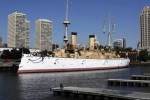You are viewing the archived version of the site.
Go to modelshipwrights.com for the current dynamic site!
Go to modelshipwrights.com for the current dynamic site!
Tuesday, September 07, 2010 - 12:11 AM UTC
AP PHILADELPHIA – The USS Olympia, a one-of-a-kind steel cruiser that returned home to a hero's welcome after a history-changing victory in the Spanish-American War, is a proud veteran fighting what may be its final battle.
Time and tides are conspiring to condemn the weathered old warrior to a fate two wars failed to inflict. Without a major refurbishment to its aging steel skin, the Olympia either will sink at its moorings on the Delaware River, be sold for scrap, or be scuttled for an artificial reef just off Cape May, N.J., about 90 miles south.
The 5,500-ton Olympia's caretakers monitor every inch of its deteriorating lower hull and deck, already covered with hundreds of patches. Independent inspectors have concluded that the ship could decay to a point beyond saving within a few years if nothing is done.
"It's an absolute national disgrace. It's an appalling situation," said naval historian Lawrence Burr, author of a book on Olympia. "She is a national symbol, and she marks critical points in time both in America's development as a country and the Navy's emergence as a global power."
Olympia, which gets about 90,000 visitors annually, closes to the public Nov. 22 to await its fate. Visitors to the museum pay up to $12, which includes the chance to board the warship.
Since taking stewardship of the floating museum from a cash-strapped nonprofit in 1996, the Independence Seaport Museum has spent $5.5 million on repairs, inspections and maintenance. But it can neither afford the $10 million to dredge the marina, tow the ship to dry-dock and restore it to fighting trim, nor the $10 million to establish an endowment to care for it in perpetuity.
"She's an icon," said Jeffrey S. Nilsson, executive director of the Historic Naval Ships Association in Smithfield, Va. "She's worthy of being saved."
Efforts to secure private or public funding have been unsuccessful, a stark reminder of recessionary times. Museum officials are reluctantly mulling whether to scrap the National Historic Landmark, said to be the world's oldest steel warship still afloat, or have the Navy sink it off the coast of Cape May.
The 344-foot-long protected cruiser ideally should have been dry-docked every 20 years for maintenance. Instead it has been dutifully bobbing — and quietly wasting away — in the Delaware since 1945 without a break from the wind and waves.
The waterline is marked with scores of patches, and sections of the mazelike lower hull are so corroded that sunlight shines through. Above deck, water sneaks past the concrete and rubberized surface layers, past the rotting fir deck underneath, and onto the handsomely appointed officers' quarters below.
"She generally looks good for her age, but her expensive pre-existing conditions make it daunting," said Jesse Lebovics, longtime caretaker of Olympia. "We're still hoping someone will step up. We're hoping for an 11th-hour reprieve."
Two local nonprofits — Friends of the Cruiser Olympia and The Cruiser Olympia Historical Society — are striving to drum up money, manpower and publicity from other historic preservation groups, veterans organizations and corporate sponsors.
"We don't want to see the ship reefed and the museum doesn't either," said Jay Richman, president of Friends of the Cruiser Olympia. "We're optimistic that a bunch of small groups working together for a common cause can save the ship."
Olympia steamed out of San Francisco in 1892 and served most notably as flagship of the Asiatic Squadron in the Spanish-American War.
Its vertical reciprocating engines, refrigeration system and hydraulic steering previewed the technological advances to come; its vestigial sails and oak-paneled, parlor-like officers' quarters marked the passing Victorian era.
From Olympia's bridge on May 1, 1898, during the Battle of Manila Bay in the Phillippines, Commodore George Dewey uttered the famous command: "You may fire when you are ready, Gridley." The Spanish fleet was decimated, making Dewey — and the Olympia — national heroes.
In a letter home after the victorious battle, Capt. Charles Gridley wrote: "We did not lose a man in our whole fleet, and had only six wounded, and none of them seriously. ... The Olympia was struck seven or eight times, but only slightly injured, hardly worth speaking of."
The ship later was active in the Atlantic, Caribbean and Mediterranean, served as a Naval Academy training vessel, and took part in the 1918 Allied landing at Murmansk during the Russian Civil War.
Its final mission was bringing home the body of World War I's Unknown Soldier from France in 1921. The vessel was decommissioned in 1922 and was largely forgotten until it was nearly scrapped in the 1950s — and local citizens rallied with donations and labor to bring it back from the brink.
Olympia opened as a museum in 1958 but funding woes and threats of sale or scrap have been part of its history ever since. The Seaport Museum itself has weathered its own share of storms, most recently in 2008, when a former president of the organization was convicted of bilking the institution of more than $1 million.
Meanwhile, two other beleaguered vessels nearby are similarly awaiting saviors: the USS New Jersey battleship across the river in New Jersey and the historic 1950s cruise ship SS United States three miles downriver.
By JOANN LOVIGLIO, Associated Press Writer Joann Loviglio
Images-AP/Matt Rourke
Interested in helping to save the Olympia?
Friends of the Cruiser Olympia
The Cruiser Olympia Historical Society
The 5,500-ton Olympia's caretakers monitor every inch of its deteriorating lower hull and deck, already covered with hundreds of patches. Independent inspectors have concluded that the ship could decay to a point beyond saving within a few years if nothing is done.
"It's an absolute national disgrace. It's an appalling situation," said naval historian Lawrence Burr, author of a book on Olympia. "She is a national symbol, and she marks critical points in time both in America's development as a country and the Navy's emergence as a global power."
Olympia, which gets about 90,000 visitors annually, closes to the public Nov. 22 to await its fate. Visitors to the museum pay up to $12, which includes the chance to board the warship.
Since taking stewardship of the floating museum from a cash-strapped nonprofit in 1996, the Independence Seaport Museum has spent $5.5 million on repairs, inspections and maintenance. But it can neither afford the $10 million to dredge the marina, tow the ship to dry-dock and restore it to fighting trim, nor the $10 million to establish an endowment to care for it in perpetuity.
"She's an icon," said Jeffrey S. Nilsson, executive director of the Historic Naval Ships Association in Smithfield, Va. "She's worthy of being saved."
Efforts to secure private or public funding have been unsuccessful, a stark reminder of recessionary times. Museum officials are reluctantly mulling whether to scrap the National Historic Landmark, said to be the world's oldest steel warship still afloat, or have the Navy sink it off the coast of Cape May.
The 344-foot-long protected cruiser ideally should have been dry-docked every 20 years for maintenance. Instead it has been dutifully bobbing — and quietly wasting away — in the Delaware since 1945 without a break from the wind and waves.
The waterline is marked with scores of patches, and sections of the mazelike lower hull are so corroded that sunlight shines through. Above deck, water sneaks past the concrete and rubberized surface layers, past the rotting fir deck underneath, and onto the handsomely appointed officers' quarters below.
"She generally looks good for her age, but her expensive pre-existing conditions make it daunting," said Jesse Lebovics, longtime caretaker of Olympia. "We're still hoping someone will step up. We're hoping for an 11th-hour reprieve."
Two local nonprofits — Friends of the Cruiser Olympia and The Cruiser Olympia Historical Society — are striving to drum up money, manpower and publicity from other historic preservation groups, veterans organizations and corporate sponsors.
"We don't want to see the ship reefed and the museum doesn't either," said Jay Richman, president of Friends of the Cruiser Olympia. "We're optimistic that a bunch of small groups working together for a common cause can save the ship."
Olympia steamed out of San Francisco in 1892 and served most notably as flagship of the Asiatic Squadron in the Spanish-American War.
Its vertical reciprocating engines, refrigeration system and hydraulic steering previewed the technological advances to come; its vestigial sails and oak-paneled, parlor-like officers' quarters marked the passing Victorian era.
From Olympia's bridge on May 1, 1898, during the Battle of Manila Bay in the Phillippines, Commodore George Dewey uttered the famous command: "You may fire when you are ready, Gridley." The Spanish fleet was decimated, making Dewey — and the Olympia — national heroes.
In a letter home after the victorious battle, Capt. Charles Gridley wrote: "We did not lose a man in our whole fleet, and had only six wounded, and none of them seriously. ... The Olympia was struck seven or eight times, but only slightly injured, hardly worth speaking of."
The ship later was active in the Atlantic, Caribbean and Mediterranean, served as a Naval Academy training vessel, and took part in the 1918 Allied landing at Murmansk during the Russian Civil War.
Its final mission was bringing home the body of World War I's Unknown Soldier from France in 1921. The vessel was decommissioned in 1922 and was largely forgotten until it was nearly scrapped in the 1950s — and local citizens rallied with donations and labor to bring it back from the brink.
Olympia opened as a museum in 1958 but funding woes and threats of sale or scrap have been part of its history ever since. The Seaport Museum itself has weathered its own share of storms, most recently in 2008, when a former president of the organization was convicted of bilking the institution of more than $1 million.
Meanwhile, two other beleaguered vessels nearby are similarly awaiting saviors: the USS New Jersey battleship across the river in New Jersey and the historic 1950s cruise ship SS United States three miles downriver.
By JOANN LOVIGLIO, Associated Press Writer Joann Loviglio
Images-AP/Matt Rourke
Interested in helping to save the Olympia?
Friends of the Cruiser Olympia
The Cruiser Olympia Historical Society
Click Star to Rate
2 readers have rated this story.
THIS STORY HAS BEEN READ 5,278 TIMES.


















Comments